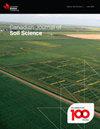存在低渗透体时土壤柱中的水和盐传输特性
IF 1.5
4区 农林科学
Q4 SOIL SCIENCE
引用次数: 0
摘要
土壤水分入渗是影响地表径流、土壤侵蚀和土壤溶质运移的重要因素。增加土壤入渗可以减少径流和侵蚀。低渗体的存在可以增强土壤的入渗能力。然而,不同深度的低渗透体对水渗透和盐转移的影响尚不清楚。在这项工作中,我们利用15根土壤柱(内径23 cm,长50 cm)评估了不同深度(对照(CK), 0、0.5、1和1.5 cm)的低渗透体对粉质壤土水盐运动的影响。实验结果表明,低渗透体提高了渗透速率和湿锋迁移速率。入渗速率和湿润锋推进速率随埋深的增加而减小。与对照相比,当湿润锋深度达到20 cm时,0、0.5、1和1.5 cm埋深处理的入渗时间分别缩短了72.24%、56.29%、44.61%和31.01%。同时,低渗透体的存在导致同一土层土壤含水量和含盐量的增加,说明低渗透体增强了土壤持水能力,减少了盐分向深层土壤的渗漏。采用菲利普模型和代数模型对渗透过程进行了描述。拟合结果表明,Philip模型的吸附系数随埋深的增加而增加,而代数模型的综合形状系数则减小。因此,本研究为低渗体在提高土壤入渗能力和控制盐分运移方面的应用提供了参考。土壤的渗透是影响土壤表面水分流动的重要因素,土壤的侵蚀是影响土壤表面水分流动的重要因素,土壤的迁移是影响土壤表面水分流动的重要因素。Quand ' l '渗透增强,我们的叛乱分子和我的叛乱分子都得到了改善。La pracemassence d 'un corps peu permassable dans le sol peut accrotre l 'infiltration d 'eau。除此之外,如果不考虑风力的影响,将会促进空气的渗透,使空气的运输变得更加复杂。在不同的范围内(如:在不同的范围内,如:在不同的范围内(如:在不同的范围内,如:在不同的范围内,如:在不同的范围内,如:在不同的范围内,如:在不同的范围内,如:在不同的范围内,如:在不同的范围内,如:在不同的范围内,如:在不同的范围内,如:在不同的范围内,如:在不同的范围内,如:在不同的范围内,如:在不同的范围内,如:在不同的范围内,如:在不同的范围内,如:在不同的范围内,或在不同的范围内,或在不同的范围内,或在不同的范围内,或在不同的范围内,或在不同的范围内,或在不同的范围内,或在不同的范围内,或在不同的范围内。从经验的角度看,从经验的角度看,从渗透的角度看,从经验的角度看,从经验的角度看,从经验的角度看,从经验的角度看,从经验的角度看,从经验的角度看,从经验的角度看。“两个参数”的减少,“度量值”的增加,“度量值”的增加,“度量值”的增加,“度量值”的增加。与对照对照(0、0、5、1和1、5 cm)相比,où在20 cm深度的前降水、前降水、前降水分别为72、24%、56%、29%、44、61%和31、01%。与此平行的是,有一组可交换的交换条件,即有一组可交换的交换条件,即有一组可交换的交换条件,即有一组可交换的交换条件,即有一组可交换的交换条件,即有一组可交换的交换条件,即有一组可交换的交换条件,即有一组可交换的交换条件。“我的事业是成功的”“我的事业是成功的”“我的事业是成功的”“我的事业是成功的”根据调整的范围,根据固定的范围,根据菲利普模数,根据增加的范围,根据模数的范围,根据模数的范围,根据模数的范围,根据模数的范围,根据模数的范围,根据模数的范围,根据模数的范围,根据模数的范围,根据模数的范围,根据模数的范围,根据模数的范围,根据模数的范围,确定模数的范围。这个练习曲servira德德参考点的课一个队一些渗透为改良la capacite d 'infiltration等控制器le称为“des sels。[贸易协定]本文章由计算机程序翻译,如有差异,请以英文原文为准。
Water and salt transport characteristics in a soil column in the presence of a low-permeable body
Abstract Soil water infiltration is an important factor affecting surface runoff, soil erosion, and soil solute transmission. Increasing soil infiltration reduces runoff and erosion. The presence of low-permeable body in soil can enhance soil infiltration capacity. However, different depths of low-permeable body have unknown effects on water infiltration and salt transfer. In this work, we evaluated the effects of low-permeable body with varied depths (control (CK), 0, 0.5, 1, and 1.5 cm) on silty loam soil water and salt movement using 15 soil columns (23 cm internal diameter, 50 cm length). Experimental results showed that low-permeable body increased infiltration rate and wetting front migration rate. Infiltration rate and wetting front propulsion rate decreased with the increase of the burial depth. Compared with the CK, when the depth of wetting front reached 20 cm, the infiltration time of 0, 0.5, 1, and 1.5 cm burial depth treatment was shortened by 72.24%, 56.29%, 44.61%, and 31.01%, respectively. Simultaneously, the existence of low-permeable body led to the increase of soil water content and salt content in the same soil layer, which indicated that the low-permeable body enhanced the soil holding capacity and reduced the salt leakage to the deep soil. Furthermore, the Philip’s model and the algebraic model were used to describe the infiltration process. Fitting results showed that the sorptivity in the Philip’s model increased with burial depth, while the comprehensive shape coefficient in the algebraic model decreased. Therefore, this study provides a reference for the application of low-permeable body in the improving soil infiltration capacity and controlling salt transport. Résumé L’infiltration de l’eau dans le sol est un facteur important qui affecte le ruissellement en surface, l’érosion du sol et le transport des solutés. Quand l’infiltration augmente, le ruissellement et l’érosion s’amenuisent. La présence d’un corps peu perméable dans le sol peut accroître l’infiltration d’eau. Cependant, on ignore quels effets il pourrait avoir sur l’infiltration et le transport des sels selon la profondeur d’enfouissement. Les auteurs ont évalué les effets d’un corps peu perméable situé à diverses profondeurs (témoin (CK), 0, 0,5, 1, 1,5 cm) sur la concentration d’eau dans un loam limoneux et sur le déplacement des sels en recourant à 15 colonnes de sol (23 cm de diamètre interne, 50 cm de longueur). Les résultats de l’expérience montrent que le corps peu perméable augmente le taux d’infiltration et la vitesse de déplacement du front d’humectation. Ces deux paramètres diminuent à mesure que s’accroît la profondeur de l’enfouissement. Comparativement au traitement CK, où le front d’humectation a atteint 20 cm de profondeur, le temps d’infiltration s’est respectivement raccourci de 72,24 %, 56,29 %, 44,61 % et 31,01 % avec une profondeur d’enfouissement de 0, 0,5, 1 et 1,5 cm. Parallèlement, l’existence d’un corps peu perméable a entraîné une hausse de la teneur en eau dans la même couche de sol, signe que ce corps améliore la capacité de rétention du sol et freine la lixiviation des sels vers de plus grandes profondeurs. Les auteurs ont utilisé le modèle de Philip et le modèle algébrique pour décrire le processus d’infiltration. Quand on ajuste les résultats, on constate que, dans le modèle de Philip, la sorptivité augmente avec la profondeur de l’enfouissement alors que dans le modèle algébrique, c’est le coefficient de la forme générale qui diminue. Cette étude servira de point de référence à l’usage d’un corps peu perméable pour améliorer la capacité d’infiltration et contrôler le déplacement des sels. [Traduit par la Rédaction]
求助全文
通过发布文献求助,成功后即可免费获取论文全文。
去求助
来源期刊

Canadian Journal of Soil Science
农林科学-土壤科学
CiteScore
2.90
自引率
11.80%
发文量
73
审稿时长
6.0 months
期刊介绍:
The Canadian Journal of Soil Science is an international peer-reviewed journal published in cooperation with the Canadian Society of Soil Science. The journal publishes original research on the use, management, structure and development of soils and draws from the disciplines of soil science, agrometeorology, ecology, agricultural engineering, environmental science, hydrology, forestry, geology, geography and climatology. Research is published in a number of topic sections including: agrometeorology; ecology, biological processes and plant interactions; composition and chemical processes; physical processes and interfaces; genesis, landscape processes and relationships; contamination and environmental stewardship; and management for agricultural, forestry and urban uses.
 求助内容:
求助内容: 应助结果提醒方式:
应助结果提醒方式:


